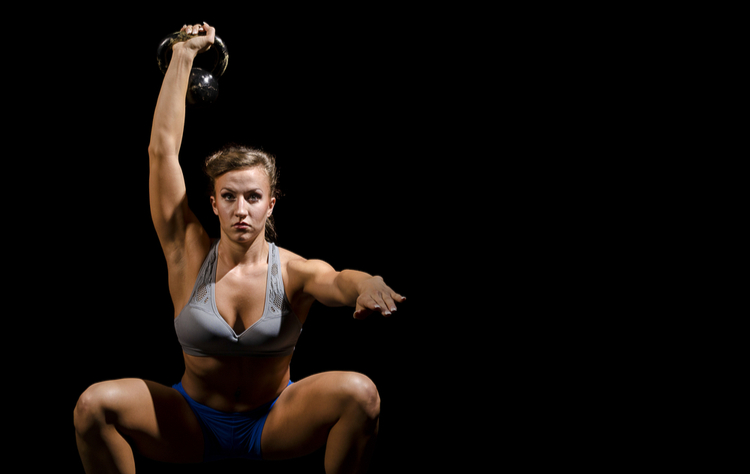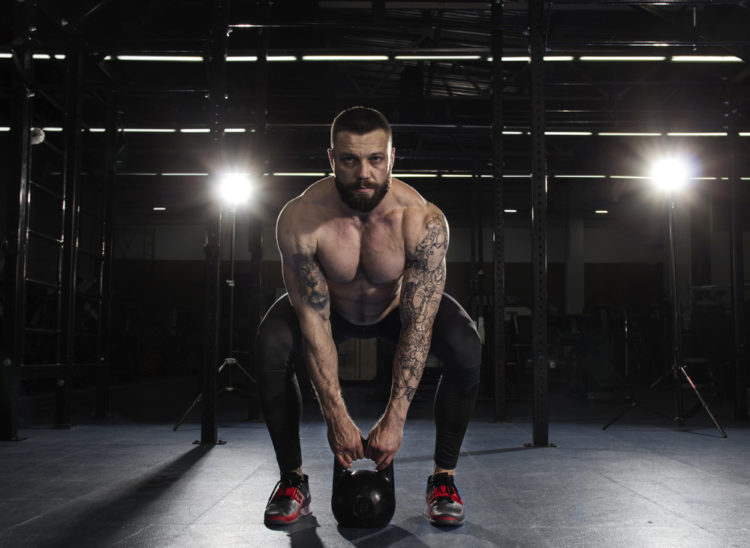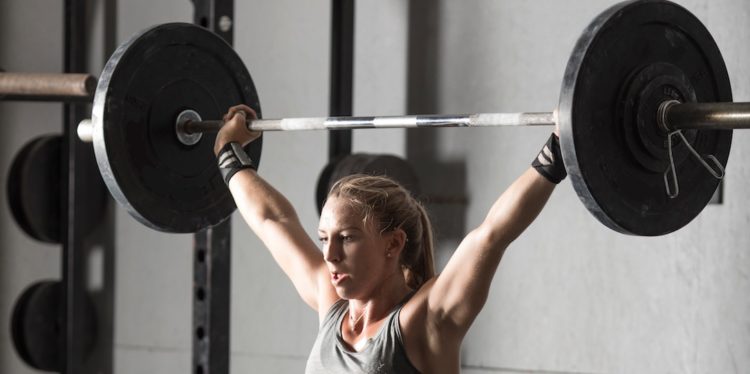Whether you’re trying to improve your strength and power, or you’re an endurance athlete looking to build some serious muscular stamina, the kettlebell snatch is a brilliant move for you to learn. I’m not gonna lie: the kettlebell snatch is a very technically demanding lift. But once you master it and integrate it into your programming, you’ll reap all kinds of power, strength, and endurance benefits — not to mention, you’ll look like a total badass.
Consider this guide your resource to all things kettlebell snatch. Together, we’ll cover the following:
- Benefits of Kettlebell Snatches
- Muscles Worked by Kettlebell Snatch
- Progressions to Work up to the Kettlebell Snatch
- Kettlebell Snatch Form and Technique
- Top 3 Kettlebell Snatch Mistakes
- Integrating the Kettlebell Snatch into Your Program
- Kettlebell Snatch Variations

Benefits of Kettlebell Snatches
The benefits of kettlebell snatches are bountiful indeed. Endurance athletes will get high-intensity cardio training and increases in muscular power without risking the repetitive stress injuries that often accompany distance running or cycling. And strength athletes will also reap the benefits of high-intensity cardio (because let’s be real, we avoid it like the plague) while developing power that’s going to help dominate on the lifting platform. Everybody wins.
Low-Impact, But High-Intensity Cardio
Whether you’ve got plantar fasciitis or you’re just generally on the hunt for high-intensity exercises that won’t require slamming your joints around, kettlebell snatches are going to work wonders for your cardiovascular endurance while remaining relatively gentle on your joints. Because you’re initiating the movement with your hips, driving it through with a high pull, and snatching the bell over your head for the big finish, you’re literally moving the weight from (over)head to toe — and that requires a lot of cardiovascular investment. It won’t take you too many rounds to feel the cardio burn, and trust me — there’s no way you’ll call this type of cardio boring.
[Related: Got 15 minutes? Try this low impact, high intensity kettlebell circuit]
Develop (Ultimate) Power
Power is a complicated thing, but when we’re talking about barbells and kettlebells, it gets just a bit simpler. In terms of lifting (and physics), power refers to the amount of force generated in a given amount of time. (Some like to summarize power by calling it strength plus speed.) Think about it this way: you warm-up, do your ramp-up sets, and settle under the bar for a set of four heavy squats. If you power (pun intended) through the first two, with the bar moving relatively easily and quickly, you’re probably going to feel more confident heading into your last two.

Look, the faster you’re able to move a loaded bar, the more physically powerful you are at that given lift. (That puts the power in powerlifting. I really need to stop the puns, but I’m not all that sorry).
The quick movement of a kettlebell snatch, that forceful, incredible generation of sheer power, isn’t just for adrenaline-seeking lifters, though. If you’ve ever run a race or done some sprints, you know you need that boost of power — the ability to immediately go from zero to a lot — to improve your endurance game. And kettlebell snatches will do just that.
Your Muscles Get More Mobile and More Stable
The kettlebell snatch might look like a solely momentum-based movement, and parts of it certainly are! But the amazing thing about this lift is that to do it right, your body needs to develop both spectacular mobility and excellent stability. Mobility, because your thoracic spine needs to be mobile enough to bring the weight from a high pull and overhead.
Stability, because your glenohumeral joint needs to be stable enough to support the rapid transitions the movement takes your shoulders through, controlling both the press to the top of the lift and the sudden descent back down.
Improve Kinesthetic Awareness
Your entire body needs to work as a single unit to get this lift right (and trust me, you want to get it right). Practicing this lift will therefore greatly increase your kinesthetic awareness, a.k.a your ability to know where your body is in space and how to effectively move through it. Poor kinesthetic awareness will improve with practice, and you’ll be able to tell you’re getting better at it when the bell stops smacking your forearm at the top of the lift (a glorious day it will be).

How does that matter, though (aside from having mercy on your forearms)? Well, improved body awareness definitely translates into better gymming — the more connected you are to your body, the more intuitively you’ll be able to keep steady on your bar path during heavy lifts. But it also translates into better living. After I started doing complicated lifts like these, I got a lot less clumsy in general life. Which is saying something, considering that I spent much of my childhood with broken fingers due to, well… rough and tumble clumsiness.
Muscles Worked by Kettlebell Snatch
Everything. End of section.
Just kidding. (Sort of.)
The kettlebell snatch is a brilliant full-body workout, and it is full-body in the true sense of the word. First and foremost, let’s dive right into the muscle that powerlifters often overlook: your heart. According to a 2015 study published in the Journal of Strength and Conditioning Research, kettlebell snatch training was more effective than free weight and bodyweight circuit training at improving the maximal oxygen uptake (VO2 max) of seventeen young women athletes’ maximal oxygen uptake.(1) So improving the muscle that is your heart? Check.
The swing part of kettlebell snatches is absurdly effective at activating your glutes, hamstrings, core, hip flexors, and quads, while the high pull and eventual push through at the end are spectacular for your upper lats, traps, and delts. Even your calves get in on the fun as you stabilize your body under the weight and counteract the momentum of the bell with your body’s stability.
And finally, whether you want to improve your grip strength to bring your deadlift to the next level or efficiently bring in all your grocery bags in one trip (absolutely no one is trying to make multiple grocery trips in this house), the kettlebell snatch is great for your grip strength. Your forearms will benefit — a lot — because they’ll be doing the extra work of helping you navigate exactly how to stabilize the bell through the high pull and descent that’s part and parcel of every good kettlebell snatch.
Progressions to Work up to the Kettlebell Snatch
Kettlebell Swing
Start with your feet roughly under your hips, setting the bell on the ground about two foot-lengths in front of you. Hinge forward at the hips — don’t dip into a squat! Imagine you’re getting punched in the stomach and that should help do the trick — until you can grab the bell’s handle securely with both hands. This movement is entirely about your hips, so use momentum entirely generated from your hip snap to swing the bell back between your legs. Keep your back neutral and, when the bell swings behind you, keep it above knee-level. If that makes you worried about thwacking yourself with the bell, just cue your forearms to protect your inner thighs.
[For more, here’s our complete guide to picture perfect kettlebell swings]
Then, explosively (hips! hips! hips!) out in front of you until the bell flutters to about chest level. Rinse and fluidly repeat. Throughout the movement, keep your elbow soft but not quite bent, and your grip gentle but also firm. Once you’re comfortable with a two-handed swing, the same mechanics apply to a single-handed swing, which you definitely need to master before slipping into high pulls.
Kettlebell Windmills
If you’re looking for the glamor of a heavy bell in your hands, this one won’t feel intuitive — but you’ve definitely got to do it anyway. A great test of (and way to improve on) your shoulder stability and hamstring flexibility, being able to do successful kettlebell windmills with perfect form is a great indicator of whether you can proceed with trying a snatch.
The basics of a kettlebell windmill? Pick a light bell at first (really light) to get the form down. You want to press the bell overhead, with your grip offset so that the web between your thumb and index finger meet the curve of the handle. Your hand should be woven through the bell such that it is resting comfortably, with your wrist straight, on the back of your forearm. Pack your shoulder (imagine someone pushing your shoulder directly from the ceiling into its socket) for stability, set your feet slightly wider than hip-width, and make eye contact with the bottom of the bell. (We’ve timestamped the video below to start with a quick how-to.)
With controlled breaths, use your unweighted hand to trace down your own body, keeping eye contact with the weight — and a packed shoulder — such that your body is forming a triangle with the bell secured above your shoulder. Reach as far down with your empty hand as you can — based on flexibility, core stability, and body shape, some folks can get no further than their calf, while others will fully touch the ground with their empty palm.
Either extreme is more than okay: you’re not looking for maximum flexibility, but you are looking to make sure that your hamstrings are comfortable with the movement, and that your shoulders have both the flexibility and the stability to keep the weight straight up throughout the movement. If they don’t, cable pulls and other exercises to increase your shoulder stability are definitely a must before diving into the wild world of kettlebell snatches.
High Pull
After you’ve truly mastered the kettlebell swing (both with two hands and with one), you might be ready to take on the high pull. With the swing, all the power is coming from your hips. Your arms are functioning more as connectors between your core and the bell, but in an ideal swing, of course, the arms shouldn’t be yanking the weight at any point.
Enter the high pull. You’re still not going to yank — you’ll need more control than that — but at the top of the swing (when your arm is about parallel to the ground), you’re going to tighten that wrist to keep it straight, and you’re going to bring your elbow back behind your ear. Just like someone unwelcome is behind you and you want to elbow them in the face. (Listen, we use whatever metaphors work for us.)
The biggest challenge here will be to keep the weight from flopping down, but that’s why you’ll start training this lift with a significantly lighter weight than you would use for a regular one-handed swing.

Kettlebell Clean (And Press)
If you’re going to perform a kettlebell snatch, it’s often much more comfortable to get accustomed to weaving your hand between the handle and the bell — to avoid that forearm pain — with the bell at chest level (as with a clean) than it is to try and do it overhead (as with a snatch). So before you try for a kettlebell snatch, make sure you can do efficient cleans first.
Start with the bell on the ground between your legs, with the handle lined up with your feet. Grip the handle offset such that the web between your thumb and index finger are flush against the curve of the handle. Grip the bell so that your thumb is pointing behind you before you begin the lift. Initiating with your hips (are you detecting a theme?), drive the bell up along your rib cage, making sure your elbow doesn’t flare out in the process.
As the bell reaches rack height, weave your hand underneath the bell so it settles comfortably on your forearm instead of slapping down on it. (It will flop and hurt, more than once. Practice will help). To advance the clean into a press, push the bell from rack position (the end position of a clean) up like a shoulder press above your head. Bring it back down in a straight path, calling the weight back to your chest in a controlled manner instead of letting your arm bring it down with momentum.
[Learn more in out step by step guide to the kettlebell clean and press]
Kettlebell Snatch Form and Technique
You now know why kettlebell snatches are the coolest things since protein shakes, but you’re still not sure how to do them. Maybe you’ve seen a video, and they look awfully complicated — they are. And that’s okay: here we go.
Step Zero: Start Backwards
The infamous wrist flop is understandably a dreaded part of both kettlebell cleans and snatches. Even if you’re a pro at cleans by now, it will still help when learning the snatch to do it in reverse order. By this I mean, take the bell into your dominant hand and settle into rack position (you can use a handy-dandy clean to get it there) and press the bell overhead — a regular old unilateral kettlebell press.
But with a twist! The twist is, instead of bringing it down slow and controlled (which you do with regular presses), you’re going to flip the bell straight over your hand, using momentum to let the bell swing down from the press into the end of a kettlebell swing. Complete this process several times, sinking it into your muscle memory, so you’ll have one less thing to think about when you start integrating more steps.
Step One: One-Handed Kettlebell Swing
Now that you’ve got the reverse process down, you’re going to get through the steps of the kettlebell snatch in actual order. If you’re at this point in your process, then you know by now how to perform crisp, spectacular kettlebell swings. Brilliant. Do that. Swing through a few reps to get your confidence going and establish comfort with the bell in your hand.
Step Two: High Pull
When you’re ready, Instead of ending at chest level and letting the bell drop back down like you usually would to finish a swing, you’re going to convert the swing into a high pull. To do this, use the last bit of momentum to activate your upper lats, traps, and delts, performing a high pull with a straight wrist and a deep exhale. At the end of the high pull, tilt your forearm up (converting your angle from roughly horizontal to more vertical) to initiate the final momentum-influenced push to the ceiling. This subtle tilt will help you land the bell on the back of your forearm without bruising yourself.
https://www.instagram.com/p/B80UBvIhwvD/
Step Three: Push Through
I say push, and I mean push, but I also don’t mean it at all. Let me explain: this is not an overhead press. You are not doing a high pull, chilling in rack position, and then pressing overhead. Instead, you’re using the momentum from the swing to meld into a high pull, and you’re using the momentum from the high pull to push your hand through the bell and into the top snatch position. All of this can and should be fluid, though of course it’s more than alright if it takes you a while to get the rhythm of it.
Step Four: Swing Down
Just like you practiced in step zero, you’re going to finish your first snatch and sweep through into the next rep by flipping the bell over your hand and letting it drop (in terms of momentum — don’t actually drop the darn thing), using the momentum from the swing down to begin the next swing, and therefore, the next kettlebell snatch.
Step Five: Switch Hands And Repeat
Don’t be tempted to do more than two or three sets of 6-8 reps per side, especially when you’re first learning. But do make sure, within the limits of your body’s needs, that you’re keeping your efforts even on both sides — so count those reps carefully!
Top 3 Kettlebell Snatch Mistakes
Attempting The Lift Too Soon
You’re eager to get started, and that’s awesome. Really. But if you’re committed to learning this lift properly — and you definitely should be — you need to genuinely progress through movements. You’ll for sure wind up hurting your shoulders if you don’t have the necessary combination of shoulder flexibility and stability to get started. If you’re not hinging at the hips properly as you must with a kettlebell swing, you won’t be able to have a clear path for the bell to follow, not to mention the effects on your low back if you’re not hinging properly. Suffice it to say — don’t dive into the kettlebell snatch out of ego. Do it because you’ve trained enough to earn trying.
Forgetting to Breathe
This lift will demand a lot of your body, and even though that’s why we like it, it can also make you forget to do basic bodily things. Like breathe. Please do that. Just like any other lift, you need to make sure your heart, brain, and muscles are fully oxygenated, so make sure you’re starting the lift with a solid breath of air; give a good exhale during the high pull and snatch up; take a quick inhale with the bell at the top of the lift; and begin again.
Keeping Your Lifting Arm Straight
If you try to go straight from a swing into a snatch — without the added subtlety of a high pull — your forearm is really going to hate you. To avoid having the kettlebell flop down onto your forearm (and leave bruises for days), you need to pull the bell into a high pull at the top of the swing, and then seamlessly push your hand up and through the bell. That way, your straight wrist and change in direction will allow the bell to just loop over your hand and forearm, saving you the ever-dreaded and painful flop.

Integrating the Kettlebell Snatch Into Your Program
The kettlebell snatch is all about power, so even if you’re using it primarily to boost endurance, you don’t want to overdo it with the reps. If you’re looking for a cardio finisher to polish off a heavy lifting day, go with a lighter weight for three sets of 8 (per side) with a 30-45 second rest between full sets.
If you already have a programmed day where you do intensive kettlebell work, you’ll want to integrate the kettlebell snatch into the beginning of your workout. Because it’s extremely demanding, you want your body to be ready to go when you get these sets done. If you’re looking for a timed workout, do 15-seconds of kettlebell snatches per side (with a 30-second rest between each full set) for three minutes. If you’re looking for something rep-based, three moderately heavy sets of 4-6 (per side) with a 60-second rest between full sets will do the trick.
If you don’t already have kettlebells and power work integrated into your program, you can still work in kettlebell snatches. How and when will do it will depend on why you’re integrating the lift to begin with. If you’re primarily looking to build muscular strength and power with the lift, use the moderately heavy rep scheme (three sets of 4-6 per side) after you’ve warmed up for a day when you’re emphasizing horizontal pushes (chest and triceps). That way, your chest (one of the only major muscles not emphasized in the kettlebell snatch) will still be ready to go heavy.
If you’re trying to emphasize the cardio benefits of the lift, you’ll want to use these puppies as a finisher. Since you might be shaky by the end of your workout, choosing a lower-weight rep scheme (three sets of 8 per side with a 45-second rest between full sets) might be your best bet.

Kettlebell Snatch Variations
Double Kettlebell Snatch
Once you’re super accustomed to regular old kettlebell snatches, but you want to level-up the badassery, go for a double kettlebell snatch. Same technical movements, but the balance will be different — because you’ll be holding a bell in each hand.
Dumbbell Snatch
With a dumbbell, you won’t be worried about a big piece of iron flopping down on your wrist, and you also won’t be swinging it like you do with a kettlebell. In terms of bell path, the dumbbell snatch more closely resembles a kettlebell clean: you’ll stay tighter and closer to your body with the dumbbell snatch, rather than engaging in a swing like you do with a kettlebell.
Barbell Snatch
And finally — not for the faint of heart, but if you’re reading this, we already know your heart laughs in the face of danger — the barbell variation of the kettlebell snatch. The mechanics are different, since you’ll be using both hands to deliver a six-foot barbell above your head — but the benefits are just as cool.
You Now Know How To Kettlebell Snatch
Pretty much all kettlebell movements are cool, but the kettlebell snatch does sort of take the proverbial cake. In terms of muscular and cardiovascular engagement, total-body mechanics, and low-impact full-body power, the kettlebell snatch is a lift that keeps on giving. You’ve just got to learn it first.
Featured image via Jacob Lund/Shutterstock

